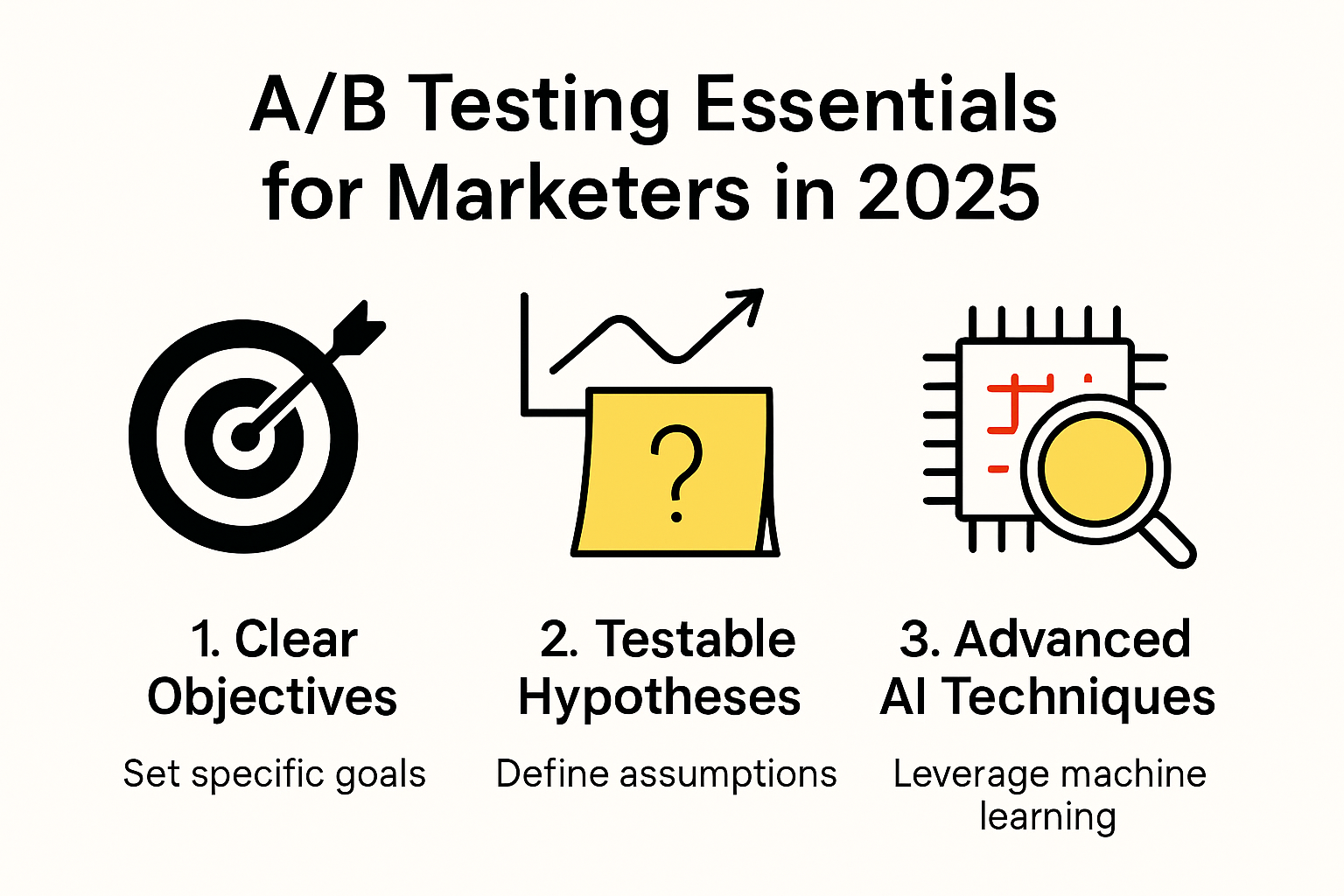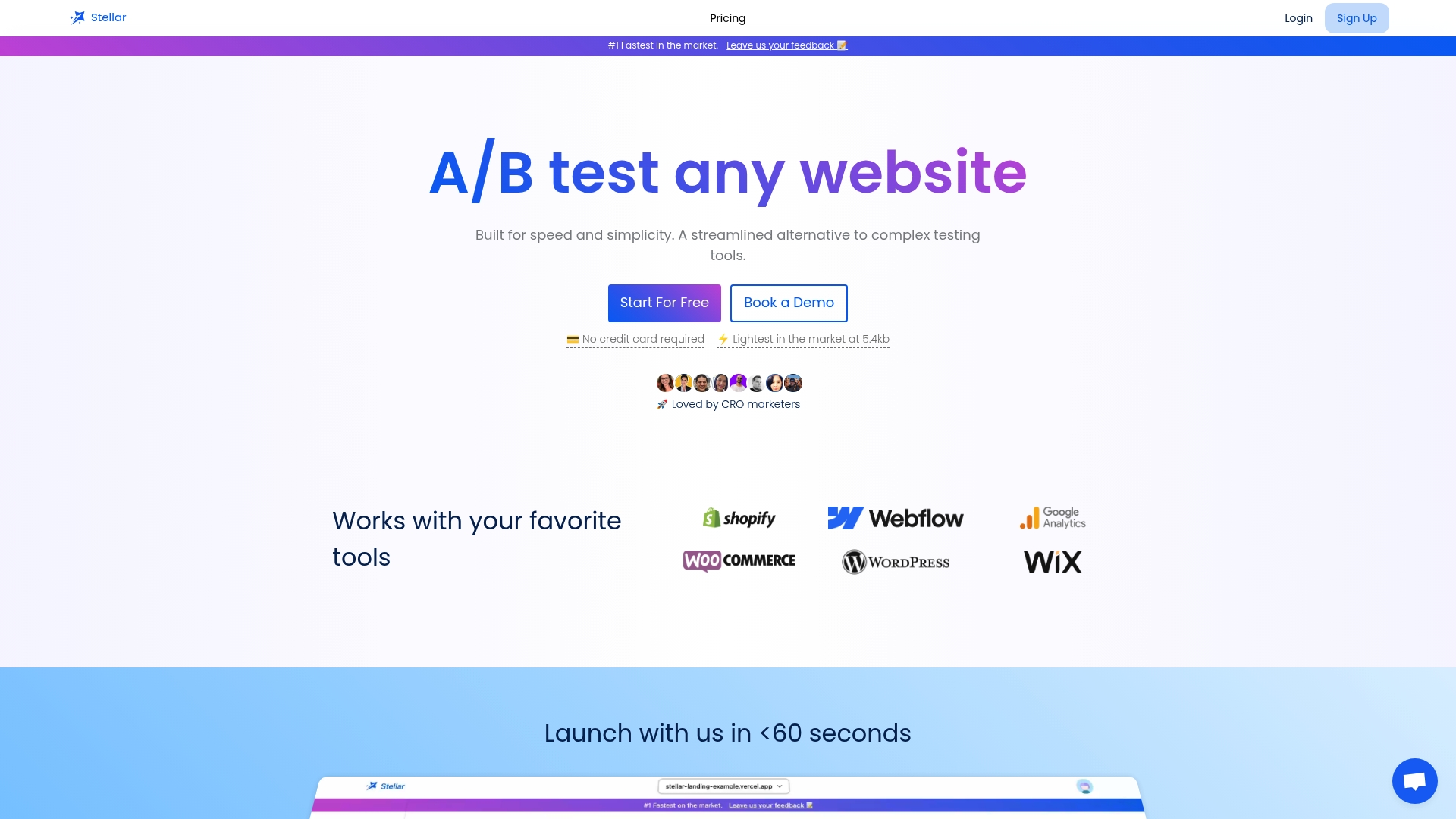
A/B Testing Checklist 2025: Essentials for Marketers

A/B testing sits at the very core of modern marketing decisions. Everyone seems to know it is valuable, but almost 70% of marketing experiments never actually influence business outcomes. Most teams repeat the same mistakes and expect different results. The truth is, mastering A/B tests in 2025 means using smarter planning, advanced AI, and much more rigorous analysis than ever before.
Table of Contents
- Pre-Test Planning And Goal Setting
- Creating And Running Effective A/B Tests
- Analyzing Results And Avoiding Common Pitfalls
- Optimizing Your Testing Strategy For 2025
Quick Summary
| Takeaway | Explanation |
|---|---|
| Define Clear Experimental Objectives | Establish precise, measurable goals that clarify what you intend to achieve with your A/B tests, such as specific conversion rate improvements or user engagement metrics. |
| Develop Testable Hypotheses | Formulate hypotheses in a predictive format that connects observable metrics to potential changes, ensuring they are grounded in data and user behavior analysis. |
| Optimize Sample Size and Duration | Carefully calculate required sample sizes to achieve statistical significance while balancing practical constraints, and choose appropriate test durations to avoid anomalies and ensure reliable data capture. |
| Analyze Results Beyond Significance | Understand statistical significance in the context of business implications, considering factors like confidence intervals and effect sizes to inform actionable decisions. |
| Embrace Advanced Techniques and AI | Incorporate advanced statistical methods and artificial intelligence to create dynamic, personalized A/B testing strategies that adapt to user interactions, leading to more precise optimization. |

Pre-Test Planning and Goal Setting
Successful A/B testing begins long before launching an experiment. Precise pre-test planning determines whether your conversion optimization efforts will yield meaningful insights or become wasted resources. Strategic goal setting transforms random testing into a powerful decision-making methodology.
Defining Clear Experimental Objectives
Establishing robust objectives represents the cornerstone of effective A/B testing. According to Microsoft Research, formulating a clear hypothesis involves three critical components: defining the problem, proposing a potential solution, and predicting the probable outcome.
Marketing teams must move beyond vague aspirations and articulate specific, measurable goals. Precise objectives might include:
- Conversion Rate Improvement: Increasing website visitor conversions by a targeted percentage
- User Experience Enhancement: Reducing bounce rates or improving engagement metrics
- Revenue Generation: Identifying design variations that directly impact sales performance
The key is specificity. Generic goals like "improve website performance" lack the precision required for meaningful experimental design. Instead, quantifiable targets such as "increase checkout completion rate by 15% within 30 days" provide clear direction and measurability.
Hypothesis Development and Validation
A robust hypothesis transforms intuition into a testable scientific statement. Penn State Extension recommends developing hypotheses that connect observable metrics with potential causal interventions.
Constructing an effective hypothesis requires understanding your current performance baseline and identifying potential optimization opportunities. This involves analyzing existing data, user behavior patterns, and potential friction points in your conversion funnel. A well-structured hypothesis follows a predictive format: "By changing [specific element], we expect [predicted outcome] because [underlying rationale]".
For instance, a hypothesis might read: "By simplifying our checkout form and reducing required fields from six to three, we expect to increase conversion rates by 12% because reduced friction minimizes user abandonment."
Strategic Experimental Design
Before launching any test, marketers must meticulously plan experimental parameters. UK Government guidance emphasizes the importance of comprehensive pre-test preparation.
Key considerations include:
- Sample Size Determination: Calculate statistically significant participant numbers
- Test Duration Planning: Establish appropriate timeframes for capturing reliable data
- Variation Development: Create meaningful alternative versions that isolate specific variables
- Success Metric Selection: Choose relevant key performance indicators aligned with experimental objectives
Pre-test planning demands a systematic approach that transforms A/B testing from a random exploration into a structured, insights-driven process. By investing time in meticulous preparation, marketers can maximize the probability of generating actionable intelligence that drives meaningful business improvements.
To help you keep track of vital pre-test activities, the table below summarizes key steps for effective A/B test planning.
| Pre-Test Step | Description | Example |
|---|---|---|
| Define Objectives | Set specific, measurable test goals | Increase checkout completion by 15% |
| Develop Testable Hypothesis | Connect proposed changes to expected outcomes | Fewer fields will reduce abandonment |
| Determine Sample Size | Calculate required participant numbers for significance | Use statistical calculator for web visitors |
| Plan Test Duration | Decide timeframe to run the test for reliable data | 30 days to capture typical cycles |
| Create Variations | Develop alternative versions isolating tested variables | Original vs. simplified checkout form |
| Select Success Metrics | Identify KPIs matched to objectives | Conversion rate, bounce rate |
Creating and Running Effective A/B Tests
Transforming your A/B testing strategy from theoretical planning to practical execution requires meticulous attention to detail and a systematic approach. The process involves carefully designing experiments that generate actionable insights while maintaining statistical rigor and operational efficiency.
Designing Controlled Experimental Environments
Successful A/B testing hinges on creating controlled environments that minimize external variables. According to research from the UK Government, randomization represents the critical mechanism for ensuring participant groups are fundamentally similar. This approach guarantees that observed differences result from intentional variations rather than underlying group disparities.
Key considerations for experimental design include:
- Participant Segmentation: Ensure representative sample selection
- Controlled Variable Management: Isolate specific elements being tested
- Randomized Group Assignment: Prevent selection bias
Randomization eliminates potential confounding factors that might skew experimental results. By distributing participants randomly across control and variation groups, researchers can attribute performance differences directly to the tested intervention.
Sample Size and Duration Optimization
Advanced research from academic computational experiments highlights the mathematical complexity of determining appropriate sample sizes. Marketers must balance statistical significance with practical constraints like time and resources.
Precise sample size calculation involves multiple strategic considerations:
- Anticipated effect magnitude
- Desired statistical confidence levels
- Minimum detectable improvement threshold
- Potential variability in user behavior
Experimental duration should accommodate natural fluctuations in user engagement. Short tests risk capturing momentary anomalies, while overly extended tests can introduce external environmental influences that compromise result integrity.
Metric Selection and Result Interpretation
Comprehensive research on online controlled experiments emphasizes the critical importance of selecting appropriate metrics. Beyond primary conversion objectives, marketers must incorporate secondary metrics and guardrail indicators that prevent unintended negative consequences.
Effective metric frameworks typically include:
- Primary Outcome Metrics: Direct conversion measurements
- Supporting Performance Indicators: Engagement and user experience signals
- Guardrail Metrics: Indicators preventing potential negative impacts
Interpreting test results requires nuanced statistical analysis. Statistical significance alone does not guarantee practical importance. Marketers must evaluate effect sizes, confidence intervals, and potential long-term implications before implementing changes.
Running effective A/B tests demands a blend of scientific methodology and strategic thinking. By maintaining rigorous experimental standards and focusing on meaningful, actionable insights, marketers can transform data into powerful optimization strategies that drive tangible business improvements.

Analyzing Results and Avoiding Common Pitfalls
Transforming raw A/B testing data into meaningful insights requires a strategic approach that goes beyond surface-level statistical interpretation. Marketers must develop sophisticated analytical skills to extract actionable intelligence while navigating potential statistical and methodological challenges.
Statistical Significance and Interpretation
Penn State Extension emphasizes the critical importance of understanding statistical significance beyond mere numerical outputs. Effective result analysis demands a nuanced approach that considers both statistical validity and practical business implications.
Key considerations for robust result interpretation include:
- Confidence Interval Assessment: Evaluate the range of potential outcomes
- Effect Size Measurement: Determine the practical magnitude of observed differences
- Contextual Performance Evaluation: Compare results against initial hypotheses
Statistical significance does not automatically translate to business value. A statistically significant 2% conversion improvement might be mathematically meaningful but potentially inconsequential from a financial perspective. Marketers must contextualize numerical findings within broader strategic objectives.
Avoiding Common Experimental Biases
Harvard Business Review research highlights numerous cognitive and methodological biases that can compromise A/B testing integrity. Understanding these potential pitfalls becomes crucial for generating reliable insights.
Common biases to mitigate include:
- Confirmation Bias: Unconsciously seeking results that validate preexisting beliefs
- Sample Selection Bias: Failing to ensure representative participant groups
- Premature Conclusion Syndrome: Drawing definitive conclusions from insufficient data
To help you avoid common pitfalls that can compromise the integrity of your A/B testing results, the table below summarizes frequent biases and how to mitigate them.
| Bias Type | Description | Mitigation Strategy |
|---|---|---|
| Confirmation Bias | Seeking results that validate preexisting beliefs | Stay open to all outcomes and use objective analysis |
| Sample Selection Bias | Non-representative groups skewing results | Use true randomization and representative samples |
| Premature Conclusion Syndrome | Drawing conclusions from insufficient data | Wait for adequate sample size and significance |
Successful marketers approach A/B testing with scientific skepticism. They remain open to unexpected outcomes and resist the temptation to manipulate data or interpretation to align with predetermined expectations.
External Factors and Contextual Considerations
UK Government guidance underscores the importance of recognizing external variables that might influence experimental results. Contextual awareness prevents misattribution of performance changes to tested interventions.
Critical external factors to monitor include:
- Seasonal Variations: Marketing performance fluctuations during specific periods
- Concurrent Marketing Activities: Potential interference from other campaigns
- Platform or Technology Changes: Technical updates that might impact user behavior
Comprehensive result analysis extends beyond immediate numerical comparisons. Marketers must develop a holistic understanding of the broader ecosystem in which experiments occur. This approach transforms A/B testing from a mechanical process into a strategic intelligence gathering mechanism.
Mastering result analysis requires continuous learning and methodological refinement. By developing a disciplined approach to interpreting experimental data, marketers can unlock powerful insights that drive meaningful business optimization strategies.
Optimizing Your Testing Strategy for 2025
As digital marketing landscapes evolve rapidly, A/B testing strategies must adapt to emerging technologies, sophisticated user behaviors, and increasingly complex optimization requirements. The future of testing demands a proactive, intelligent approach that transcends traditional experimental methodologies.
Advanced Statistical Techniques
Cutting-edge research reveals innovative statistical methods designed to address historical limitations in experimental design. These advanced approaches tackle challenges like small sample sizes and non-standard data distributions, providing marketers with more robust and reliable testing frameworks.
Emerging statistical optimization strategies include:
- Bayesian Inference Models: Enhanced probabilistic analysis
- Machine Learning Integration: Dynamic experimental parameter adjustment
- Multi-Armed Bandit Algorithms: Real-time performance optimization
Traditional significance testing often fails to capture nuanced performance variations. Modern techniques offer more granular insights, enabling marketers to make more precise, data-driven decisions with higher confidence levels.
Artificial Intelligence and Personalization
Groundbreaking research demonstrates how reinforcement learning and large language models can revolutionize A/B testing approaches. These technologies enable dynamic, personalized experimental strategies that adapt in real-time to user interactions and engagement patterns.
Key AI-driven testing innovations include:
- Predictive Variation Generation: Automatically creating test variations
- Dynamic Audience Segmentation: Intelligent participant grouping
- Automated Insight Extraction: Rapid performance pattern recognition
Artificial intelligence transforms A/B testing from a static experimental process into an adaptive, intelligent optimization mechanism. By leveraging machine learning algorithms, marketers can develop more sophisticated, responsive testing strategies.
Cross-Domain Testing Strategies
Educational research insights highlight the potential for cross-domain testing methodologies. This approach emphasizes rapid experimentation and iterative improvement across diverse operational contexts.
Cross-domain testing principles encompass:
- Scalable Experimental Frameworks: Adaptable across different business domains
- Iterative Optimization Processes: Continuous performance enhancement
- Holistic Performance Measurement: Comprehensive impact assessment
Successful marketers in 2025 will view A/B testing as a strategic intelligence gathering mechanism rather than a mere technical exercise. By embracing advanced statistical techniques, artificial intelligence, and cross-domain strategies, organizations can transform experimental data into powerful competitive advantages.
The future of A/B testing lies in developing intelligent, adaptive systems that not only measure performance but actively optimize and predict user behaviors. Marketers who invest in sophisticated testing methodologies will be best positioned to drive meaningful business growth in an increasingly complex digital ecosystem.
Frequently Asked Questions
What is A/B testing and why is it important for marketers?
A/B testing is a method of comparing two versions of a webpage or app against each other to determine which one performs better. It's important because it helps marketers make data-driven decisions that can optimize conversion rates and improve user experience.
How do I define clear objectives for my A/B tests?
To define clear objectives, establish specific, measurable goals that outline what you want to achieve, such as increasing conversion rates by a certain percentage or improving user engagement metrics.
What factors should I consider when designing A/B tests?
When designing A/B tests, consider participant segmentation, controlled variable management, randomization, sample size determination, test duration, and success metric selection to ensure reliable and valid results.
How can I analyze A/B testing results effectively?
To analyze A/B testing results effectively, assess statistical significance, evaluate confidence intervals and effect sizes, and consider the broader business context to ensure that findings are actionable and relevant.
Take Control of Your A/B Testing Success in 2025
Ready to bypass the common pitfalls outlined in the "A/B Testing Checklist 2025" and actually turn your tests into real business impact? If you are tired of complicated tools that slow your site down or require weeks to launch a simple experiment, then Stellar can help you break free. The article stressed how critical it is to establish clear experimental objectives, optimize your setup, and make data-driven decisions. Stellar was built with these exact needs in mind for marketers and growth teams who demand smarter, faster results.

Start streamlining your next experiment now. Sign up at Stellar and experience our ultra-lightweight platform with a no-code visual editor, advanced goal tracking, and real-time analytics that empower you to act on insights instantly. Stop letting technical hurdles and confusing interfaces hold you back. Visit our homepage and see how simple powerful A/B testing can be. Your first breakthrough test is just a click away.
Recommended
Published: 7/19/2025